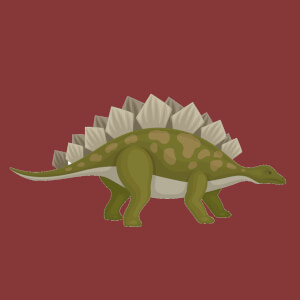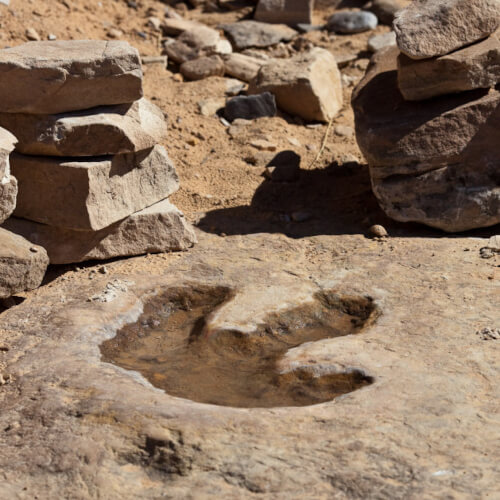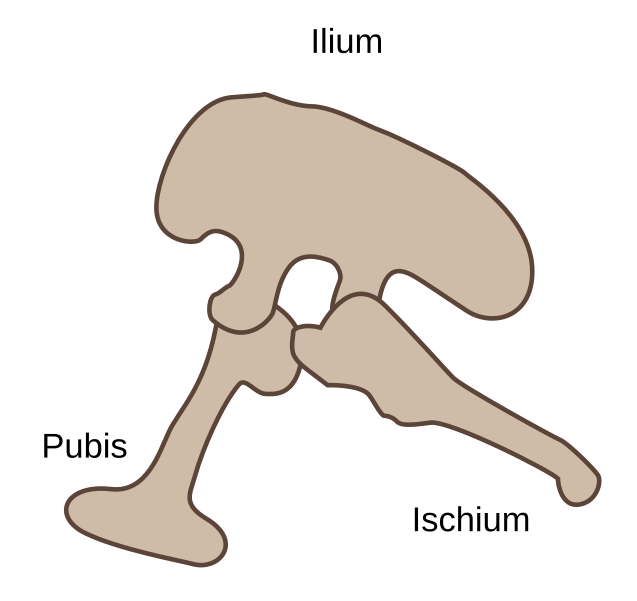



Dinosaurs, or non-avian (non-bird) dinosaurs, are an extinct group of reptiles from the clade Dinosauria. Dinosaurs first appeared between about 243-233 million years ago, and became the most common vertebrates on earth around 201.3 million years ago after the mass-extinction event between the Triassic period and the Jurassic period.
Birds, or avian dinosaurs, are the only living descendants of the dinosaurs, which majorly went extinct about 66 million years ago during another extinction event that happened between the Cretaceous period and the Paleogene period. In order to describe and classify them better, dinosaurs are usually split into two groups: the Saurischia, or lizard-hipped dinosaurs, and the Ornithischia, or bird-hipped dinosaurs.

The saurichian (from the Greek for "lizard hip joint") dinosaurs all had hipbones that separated frontwards and backwards at the bottom, just like today's modern lizards and most other reptiles. This skeletal structure, was what gave many dinosaurs the ability to walk on two legs, what scientists call bipedalism. The saurichia include all the carnivorous dinosaurs, one of the two primary groups of herbivorous dinosaurs, and, interestingly, all of the birds.
The theropoda, or theropods (from the Greek for "wild beast foot"), are a group of saurischian dinosaurs characterized by having hollow bones and three-toed arms and legs. Theropods first appeared about 231.4 million years ago, and while they largely went extinct about 66 million years ago, they are the direct ancestors of today's modern birds. Like birds, theropods walked on two legs and had relatively small arms. A few theropods you might recognize are: Tyrannosaurus rex, Velociraptor, Giganotosaurus, Megalosaurus, and Spinosaurus.
The sauropoda, or sauropods (from the Greek for "lizard foot"), are the other main group of saurischian dinosaurs. Sauropods are characterized by their long necks and tails; small heads; and four thick legs. Sauropods were herbivorous and some species grew to enormous sizes. A few well-known sauropods are: Argentinosaurus, Brachiosaurus, Diplodocus, and Brontosaurus.

The ornithischian (from the Greek for "bird hip joint") dinosaurs had hipbones that pointed backwards, much like those of today's birds. The ornithischia include mostly herbivorous dinosaurs, with the addition of a few species that were possibly omnivores. Paleontologists have found evidence that ornithischian dinosaurs likely lived in groups or herds, and some even had pelts of something that resembled modern day bird feathers.
The thyreophora (from the Greek for "shield bearer"), often called the armored dinosaurs, are a group of ornithischian dinosaurs that had thick plates of body armor. Mostly herbivorous, the thyreophora had small brains relative to their overall size. Stegosaurus and Ankylosaurus both fall into this group.
The cerapoda, or cerapods (from the Greek for "horned feet), are the other main group of ornithischian dinosaurs. Some well-known cerapods are Triceratops and Iguanodon.
A good chunk of the world's dinosaur fossil discoveries were found in the western half of North America, specifically in the United States (especially Montana, Wyoming, Utah, and Colorado) and Canada (particularly in the province of Alberta). This region is known as the "Dinosaur Belt" because of the large number of fossils that have been discovered there over the past 150 years. The fossils found in this area represent a diverse range of species, including some of the most famous dinosaurs such as T. rex, Triceratops, and Stegosaurus.
Micropachycephalosaurus was an herbivorous dinosaur that lived in what is now China during the Late Cretaceous period, about 75 million years ago. Its name, translating to "small thick-headed lizard," comes from its relatively small size and thick skull bones. First described in a scientific paper in 1978 by a team of Chinese and American paleontologists, it remains one of the most unusual and difficult-to-pronounce dinosaurs. Despite its long name, not much is known about this dinosaur, as only a few fragments of fossils have been discovered.
While there isn't a perfect way to measure the diets of extinct animals, one study published in 2012 estimated that the largest sauropods, such as Argentinosaurus and Dreadnoughtus, would have needed to consume around 400,000 to 500,000 calories per day. This estimate was based on mathematical models of sauropod energy metabolism and assumptions about the different types of plants available for them to eat. In contrast, most dieticians recommend that humans eat about 2,000-2,500 calories per day, or about 200 times less!
Though we tend to think of dinosaurs as large, ferocious meat-eating carnivores, all of the largest dinosaurs were herbivores. Because fossils of such large creatures only exist in parts, paleontologists aren't entirely sure which of the largest dinosaurs were larger than others; however, some of the largest plant-eating dinosaurs include Argentinosaurus, Patagotitan, Dreadnoughtus, and Supersaurus.
In its Greek form, the word Dinosauria was first used by English paleontologist Richard Owen in 1842 to describe the massive sizes of the dinosaur skeletons. Owen is known for his work on classifying and naming several new dinosaur species, including the dinosaurs Iguanodon, Megalosaurus, and Hylaeosaurus. He was also the founder of the Natural History Museum in London.